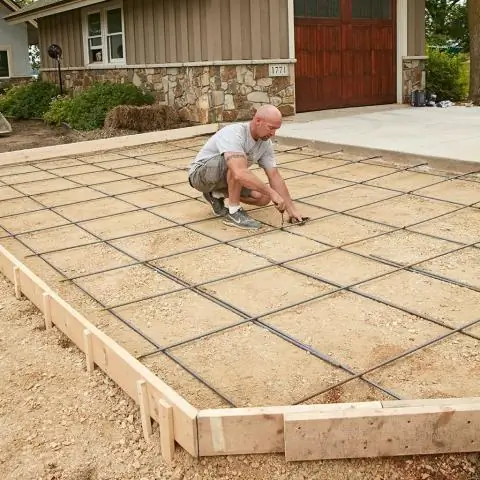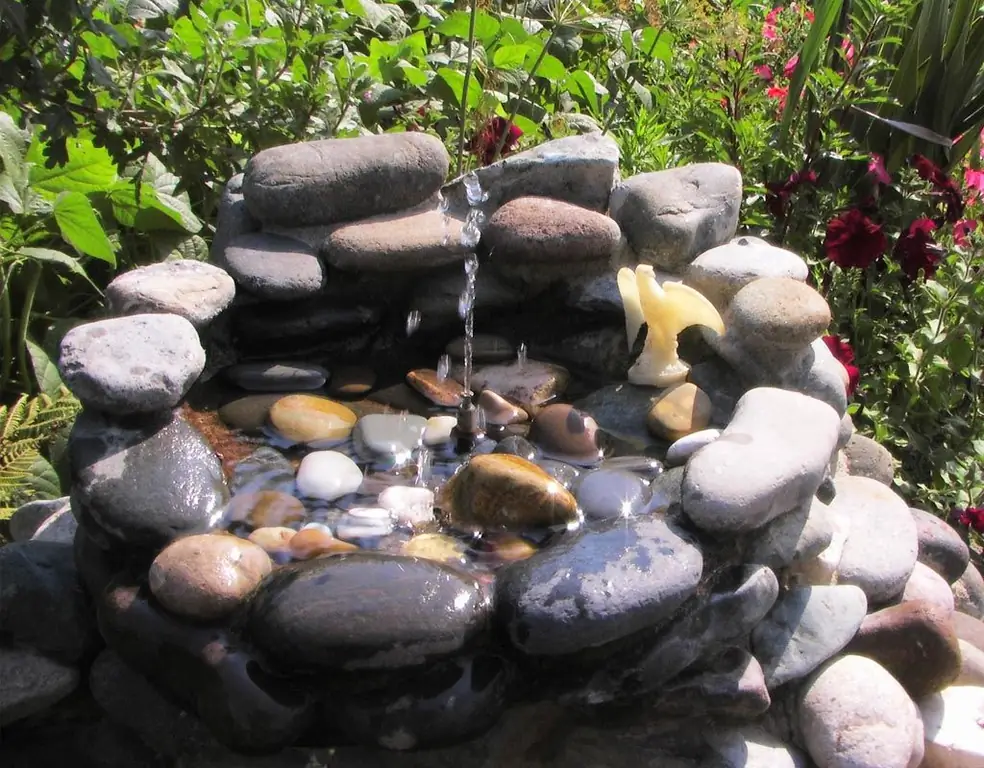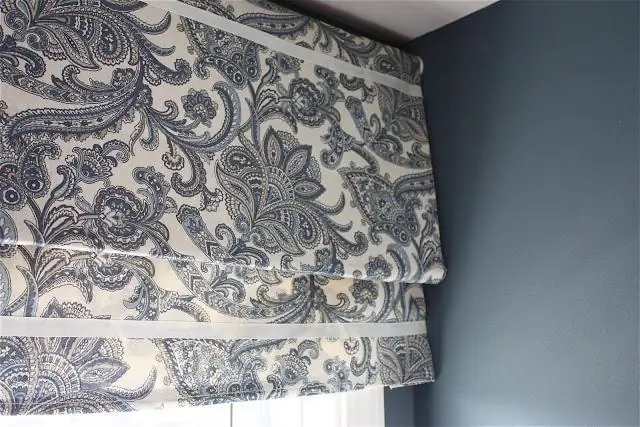
Table of contents:
- Author Bailey Albertson [email protected].
- Public 2023-12-17 12:53.
- Last modified 2025-06-01 07:32.
We make molds for paving slabs with our own hands

Owners of private houses and garden plots have long appreciated the advantage of paving slabs. Thanks to this accessory, it is so easy to transform your garden by equipping paths, platforms and small terraces on it. The cost of paving slabs can be different, and it is clear that a high-quality product will not be cheap. There is an excellent way out - independent production. But where to get the molds for the tiles? Today we will talk about how to make them yourself. It turns out that this is quite possible.
Content
- 1 How beneficial is it
-
2 Materials
- 2.1 Plastic
- 2.2 Tree
- 2.3 Plaster
- 2.4 Silicone and polyurethane
- 2.5 Table: comparison of materials for self-production of forms
-
3 Manufacturing technology
- 3.1 Wooden formwork
-
3.2 Plastic mold
3.2.1 Video: Making a Plastic Tile Base
-
3.3 Silicone mold
3.3.1 Video: Making a Silicone Tile Mold
-
3.4 Metal frame
3.4.1 Video: DIY metal frame for paving slabs
How beneficial is it
If you decide to make paving slabs yourself, then you must take into account: the mold for its ebb is the main tool. It is in it that you will pour the filler, and you can do this right in your own yard.
Of course, you can buy the molds from the store. This is the simplest solution that will take you a minimum of time. But this solution is not without its drawbacks. The first drawback of purchased forms is in the monotonous patterns and standard configuration. The second is that the tiles made in them often have to be cut to fit the track in the right way, or to change the location of the track itself. And if you decide to make the forms for the tiles yourself, then you will probably take into account all the features of the landscape in advance.

DIY paving slab mold can save you money
If you do not plan too much work, then, of course, it is much easier to buy a form in a store. But if you have to pave a large area with tiles, then independent production will justify itself
In fact, a homemade form is perhaps the most costly measure in the production of paving slabs. Perhaps this is the only drawback of self-production (besides the fact that it takes time to produce the form). But everything pays off by the volume of production of the paving slabs themselves.
Materials
In industrial production, many materials are used to create the molds in which paving slabs are cast. But for their own production at home, they are most often used:
- plastic;
- wood;
- gypsum;
- silicone and polyurethane;
-
metal.

round molds for plastic tiles Almost any improvised means can act as a form for paving slabs, even such circles, cut from plastic
These materials are readily available either in your home or at hardware stores. They are so easy to use that you can easily create a form with a simple look or complex texture. Models made of polyurethane or silicone are especially popular due to their strength and ability to repeat the pattern structure down to the smallest detail.
Plastic
The most budgetary material for making molds. Plastic bottles, containers, pallets - everything can serve as a form in the manufacture of paving slabs. For example, the bottom of five-liter bottles is cut off to the required height. And a plastic stand for a flower pot, at the bottom of which, for example, a large leaf of a plant is laid out, is a ready-made form.

A plastic mold suitable for paving slabs is sure to be found in any home
There is also a complex way of making interesting, exclusive forms. The plastic raw material is melted and poured into the formwork with a prepared template. When the mass has hardened, the tile mold can be used.
Wood
It is also a very simple material, it involves making a mold according to the formwork principle. Such a product can be made from a wooden beam or plywood that is resistant to moisture. To make a mold for paving slabs out of wood, strips of small thickness are taken, sawn into pieces with the required length, and then connected to each other using nails.

Wooden form based on formwork
Wooden formwork allows you to create tiles in simple geometric shapes.
Gypsum
The option of making molds from plaster is still very popular due to its simplicity and low cost. This material is so versatile that you can use it to create a template of any complexity.
All you need is:
- gypsum mixture (add plasticizer or cement for extra strength);
- wooden blocks for formwork;
- a cladding element that will serve as a pattern on the form;
-
grease or oil for treating the cladding element (this will prevent plaster from sticking).

plaster mold for paving slabs Forms of any configuration can be made from gypsum
After rubbing the tiles with grease, lay them inside the formwork of the required size. Pour in the plaster mass so that it covers the entire sample, plus a couple of centimeters of reserve. Although the plaster hardens quickly, let the mold stand for 24 hours to ensure reliability.
Plaster molds also have a disadvantage: they are rather fragile. A small blow is enough to damage them. This risk increases with heavy use.
Silicone and polyurethane
For the manufacture of tiles in large volumes, molds made of silicone and polyurethane are considered the most convenient. They are used to create a wide variety of models with any design sophistication down to the smallest detail.
Buy a special compound from a hardware store or hardware store that contains a hardener. You can lay out the pattern from wire, sea pebbles, sticks, figured products, or use one ready-made tile as a sample.

Silicone tile mold has many advantages over gypsum and wood molds
The sample is placed in the formwork and the liquid silicone or polyurethane mass is spread on it with a layer of at least 1 cm. After the initial hardening, the excess is cut off, and then the resulting shape is carefully separated from the workpiece.
As a result, we will conduct a comparative analysis of materials and their use for making molds.
Table: comparison of materials for self-production of forms
Material |
Quantity for 1 mold |
Time |
Level of difficulty |
| Plastic | Up to 1 kg | 1 hour of work, 24 hours for solidification | Average |
| Wood | Up to 1.5 running meters of board | About 1 hour | Plain |
| Gypsum | Up to 2 kg | 1 hour of work, 10-20 hours for solidification | Plain |
| Silicone, polyurethane | Up to 1 kg | 1 hour of work, 1 hour for solidification | Average |
Whichever option you choose, use simple tips in your work.
- Do not forget to make corner shapes if you do not plan to lay the tiles evenly, but with small kinks or corners. This will greatly facilitate the process: you do not have to cut the finished tiles.
- If you make several forms at once, do not forget that their size must be strictly the same. In addition, the tiles will need to be well connected to each other in a mosaic manner.
Manufacturing technology
Now we will describe the process of making molds from different materials in more detail. Try to adhere strictly to the technology to avoid mistakes.
Wooden formwork
Above, we have already described the process of making a mold, which is a formwork. Now let's talk about it in more detail.

The main difficulty in making a wooden mold is understanding the principle of joining parts
- Take a board and cut two pieces from it. Their length should be 3 cm longer than the edge of the paving slabs being produced.
- Cut out two more pieces, the length of which will exactly match the size of the tile. If you do not want to make rectangles or squares, but tiles of more complex geometric shapes, then for the frame you will need the appropriate number of boards.
- Fasten the resulting boards with iron corners. You will also need to screw in screws that can be easily removed after the finished product has hardened. When the solution is dry, you will need to partially disassemble the mold; that's what screws are for.
Plastic mold
As we have already said, this material is very easy to work with, it is durable and at the same time elastic.
-
The formwork will serve as the basis for the form. You already know how to make it using a wooden form as an example. The only difference is that the boards need to be fixed with screws, tightly.

formwork for form Prepare the formwork for the mold
- Using a level, be sure to check whether the sides and fasteners are even.
- Prepare a base with a picture. The material for it can be products made of clay, plasticine, concrete or plaster.
-
Before pouring the plastic, grease the base with a wax-based adhesive and, after drying, place it in the formwork.

factory plastic molds You can borrow ideas for design design from ready-made plastic forms.
-
Melt the plastic in a suitable container. Pour it into the prepared mold, spreading it evenly over its entire surface.

pouring plastic into a mold Pour melted plastic into the mold
- Wait until the plastic is completely dry. This will take about 50 minutes.
Now you can carefully separate the finished form from the sample.

Remember, finding a great off-the-shelf sample is much less expensive than melting plastic at home.
Video: making a plastic base for tiles
Silicone molds
Working with silicone is quite simple, but it requires attention and accuracy.
Silicone contains 3 components: base, hardener and catalyst. When measuring them for the preparation of the mixture, observe the proportions exactly
- Craft a container matrix. For this, any rigid material is suitable (the same wooden formwork, for example), or even a ready-made container of a suitable size. If necessary, fasten the parts of the container so that there are no gaps.
- Take a non-hardening sculptural plasticine or still soft gypsum, lay it evenly on the bottom of the container or formwork.
-
Fix the base with the pattern on the plasticine or distribute the details (stones, branches, etc.), slightly pressing in. Press it down so that the pattern is evenly printed. Remove the base elements and spread the plasticine surface with fat or oil.

mold base models Use patterned basics for original shapes
- Mix the silicone from the components according to the instructions. Pour the mixture gently into the mold. It is advisable to pour in a thin stream so that bubbles do not form in the process.
-
Wait for the mass to dry. It will take about a day. After that, you can carefully remove the form from the container.

silicone molds for tiles Ready-made silicone molds for paving slabs
Video: making a silicone mold for tiles
Metal frame
Making a mold for a metal tile with your own hands is also quite possible. However, this is not as popular because the process requires forming metal blanks and then using a welder to join the parts together. Nevertheless, the principle of operation itself is quite simple, and if you have all the necessary materials, a suitable place to work (preferably outdoors) and are not afraid of difficulties, then perhaps this option will appeal to you.
Video: DIY metal frame for paving slabs
As you can see, making molds for paving slabs is not only simple, but also promising. You can do all the work on the arrangement of your site yourself: from design development and form creation to laying tiles. And over time, you may even make business in this lesson. If you have any questions about this topic, please ask them in the comments. Good luck!
Recommended:
How To Make A Garden Fountain With Your Own Hands In The Country: Photo, Video, Step By Step Instructions

A step-by-step description of the process of building and installing a fountain from improvised means in the country with your own hands Required materials and tools
How To Make A Gazebo Out Of Wood With Your Own Hands - Step-by-step Instructions With Photos, Drawings And Video

A gazebo made of wood, who has not dreamed of having it? Now you have such an opportunity, read and get to work on making the structure yourself
How To Make A Steam Generator For A Bath (steam Gun) With Your Own Hands - Step By Step Instructions With Photos, Drawings And Video

How to make a steam generator and a steam gun for a bath with your own hands. Description of the device and its features. Instructions for creating a structure
How To Make A Door In The Bath With Your Own Hands - Step By Step Instructions With Photos, Drawings And Video

Details of the requirements for materials and construction of doors for the bath, depending on the location. DIY step-by-step making
How To Make A Septic Tank For A Private House With Your Own Hands - Step By Step Instructions With Photos, Drawings And Video

Design, principle of operation and features of installation and operation of septic tanks. DIY design and manufacture of concrete treatment facilities
